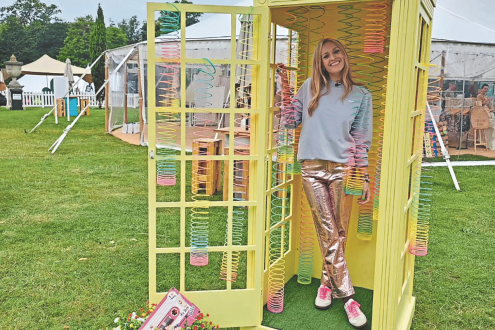Imagery meditation: how to visualise happiness
Could imagery meditation be the gateway to a happier life? Eve Menezes Cunningham shares what she’s learned about how to visualise a life you love.

Could imagery meditation be the gateway to a happier life? Eve Menezes Cunningham shares what she’s learned about how to visualise a life you love.
Imagination, according to George Bernard Shaw, is the beginning of creation. ‘You imagine what you desire, you will what you imagine, and at last, you create what you will,’ he wrote.
It’s a compelling idea – that we can harness our imagination to create a life we love. And it makes sense when you think about how often we use our imagination – albeit not always to positive effect.
How often have you heard your phone ping with a message and found your mind racing ahead to imagine the contents? You create an instant story about what the message might be before you’ve even read it. Sometimes those stories can be helpful. But often we make ourselves anxious by leaping to a worst-case scenario.
Our ancient ancestors would have gone into fight or flight mode only when they sensed a sabre-toothed tiger or similar actual threat. But in 2022, just the thought of something stressful can trigger the same flood of stress hormones. And the problem is that we don’t always make the best decisions when we’re in survival mode.
There is an antidote, however. Becoming more conscious of the stories we tell ourselves and the thoughts we think can be transformational. Reminding ourselves that we’re simply telling ourselves stories – and that we can choose to make these stories more empowering – can improve the way we show up at work, in our relationships and in the world at large.
‘Our whole perception of the world is based on imagination,’ says Dr Dina Glouberman, a psychotherapist, coach and the author of books including The Joy of Burnout, You are What You Imagine and, most recently, ImageWork, which is based on the self-help method she devised to help people harness the power of the imagination.
‘I call it Transformational Imagination because you’re actually opening up to the imagination to transform your assumptions,’ she says. ‘It’s not simply going from the negative to the positive, it’s going from the taken-for-granted way you see the world to a conscious surrender to the wisdom of your imagination. You’re guiding it.’
Dr Glouberman’s premise is that when we question our assumptions – why we fear the worst when our phone pings, for example – we can tap into the transformational power of the unconscious mind.
By imagining the outcome we dread when we get a message, or when our boss asks for an impromptu meeting, we can get curious about what feels so awful about the scenario, and what has happened in that imaginary future in order for us to get there. When we make this a more conscious process, we’re more likely to make better practical choices than when we react from a place of fight or flight.
Many people forget that no matter what we do, there will always be things beyond our control or outside our wildest dreams. But elements of Dr Glouberman’s work have changed my life. When I was preparing to move from London to the west coast of Ireland, I had no idea what to expect. I started researching houses online which felt like a huge chore until, one day, I saw what felt like the house I was born to live in.
There were so many things out of my control that I couldn’t possibly know if this would be my forever home. But I actively chose to let a screenshot of that traditional Irish cottage with its red door inspire my every thought. The image energised me. By surrendering to our imagination and our highest, wisest, truest selves like this, we can flow with life more.
As I prepared to move, the sea and mountainscape was solid in my imagination, and I never wavered even when practicalities felt tricky. I felt like it was calling me, and letting myself indulge this potential delusion gave me comfort and hope.
Likewise, when I embarked on my counseling training in 2008, I had an image that continues to guide me. Me, in an alleyway, underneath black rubbish bags, with more being thrown upon me. Feeling completely disposable. Broken. Thrown away.
Then, having expected any rescue effort to involve diggers and other scary machinery that would probably hurt, too, some angelic helpers effortlessly removed all that had been weighing me down. I drew it (badly) on a PostIt note which I still have. Even now, it reminds me that recovery can be more gentle – and powerful – than we imagine.
‘The basic thing is surrendering to what is,’ explains Dr Glouberman, when I share my image with her. ‘The reason you got so much out of that image was that you were willing to see the negative. That turns out to be gold. You have to be willing to see it. You could be working with someone who throws away that image. They try to find another one that looks more positive, but of course that isn’t so powerful.’
By reminding ourselves that we’re safe, that we welcome the insights that are for our highest good and that the process can be easy and even joyful, we make life far easier for ourselves. We don’t need to force anything.
Deep relaxation is key to helping us harness the power of the unconscious mind. With a positive intention or resolve, also known as a Sankalpa, you use all the senses to connect with what you want. Your intention might be anything that comes from your heart.
I’m currently learning to drive, so one of my current Sankalpas is that I’m joyfully driving across Ireland, singing at the top of my lungs in a cheerful-looking car. You’ll know you have a good enough Sankalpa when you can’t help but smile, from the heart, at the idea of it becoming your reality.
By imagining it, using all the senses, as we relax deeply, we get out of our own way. We stop attempting to press the brakes and accelerator at the same time and, as Dr Glouberman might say, stop dividing our own heart. By working with all the senses, we get a better sense of where blocks might be and how we can refine what we’re doing so we’re more congruent. Every cell in our being starts to support this future we’re imagining for ourselves.
Since speaking to Dr Glouberman, I’ve been integrating her approach into my daily morning meditation. I also pause throughout the day to reassess. For example, I’m currently online dating, but feel a bit out of my depth. So, prior to any date, I imagine the way I want things to go. It started out as a really low bar – not being murdered – but I’m refining my criteria. Any time I feel stressed rather than excited about anything to do with the whole process, I remind myself that it’s about fun. Then I take a few moments to reconnect with an image of what I want.
Letting go of our desired outcome is also important. For the past several years, part of my morning meditation has included offering anything and everything to the Universe. Anytime I notice myself getting stressed, I fling my arms out wide and say, ‘Thy will be done’. I’m now adding Dina’s bubble-blowing exercise, see below, to my practice. It makes me smile and reminds me that life can be so much better and easier without catastrophising. Now that I’m finally getting out of my own way, I can see the road ahead and the view is lovely.
A beginner’s guide to imagery meditation
‘Our imagination is the therapist, the healer, the wise being,’ says Dr Glouberman.
Every morning, she visualises feeling good during the day ahead. To do the same, simply pause, either before you get out of bed, on a yoga or meditation mat, or simply over your first drink of the morning. Allow your imagination to fill in as many details of a delightful day as possible.
Dr Glouberman recommends getting curious about the good feeling – don’t get bogged down by whatever it’s about, but simply feel it. Once you know what you feel, ask yourself where you feel it most strongly in your body. Get curious about any shapes, colours and sensations it suggests.
Next, ask yourself what the feeling is about. What’s at the centre of the good feeling? Mine is relief at meeting the day’s work demands during an especially busy few days preparing for a couple of days off. I imagine an enormous, happy exhalation and full-body relief.
Ask your imagination how you got to that good feeling. I know prioritising a walk during a break, even though I don’t feel like I have time, will help me achieve all I need to do and get to the moment I have imagined.
Finally, picture the image of what you want as a bubble with yourself at the centre, and ask yourself if you’re willing to do whatever you have to do to get there. Are you willing to accept that you’re not all powerful? To accept that you might not get there and that’s still OK? Say aloud, ‘I ask and intend for this to be and I release it.’ Then blow the bubble into the future.
READ MORE









